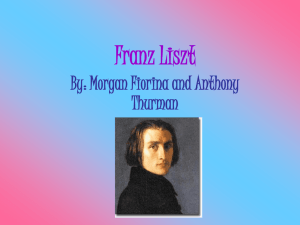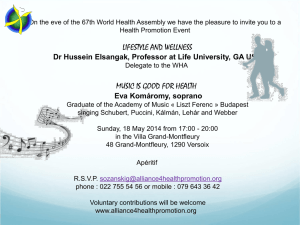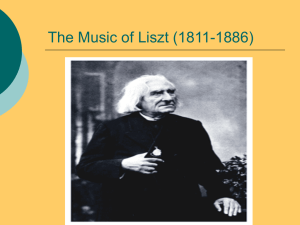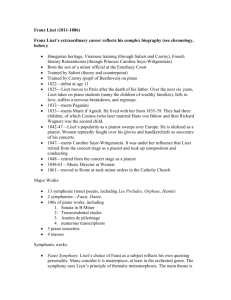Press Material
advertisement
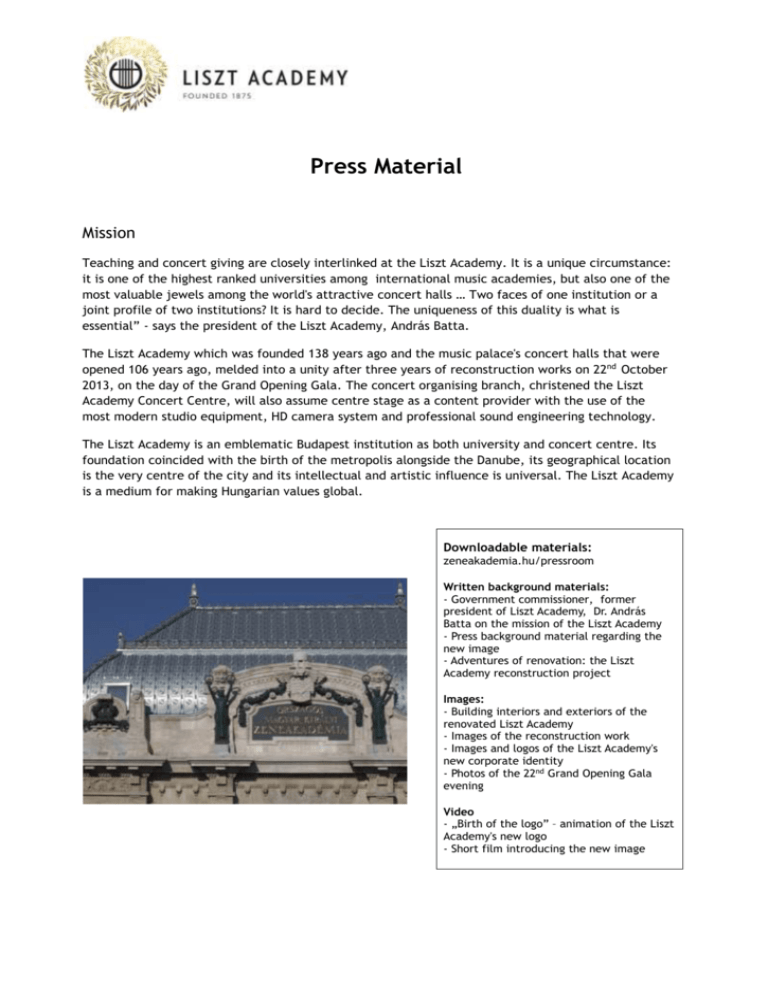
Press Material Mission Teaching and concert giving are closely interlinked at the Liszt Academy. It is a unique circumstance: it is one of the highest ranked universities among international music academies, but also one of the most valuable jewels among the world's attractive concert halls … Two faces of one institution or a joint profile of two institutions? It is hard to decide. The uniqueness of this duality is what is essential” - says the president of the Liszt Academy, András Batta. The Liszt Academy which was founded 138 years ago and the music palace's concert halls that were opened 106 years ago, melded into a unity after three years of reconstruction works on 22nd October 2013, on the day of the Grand Opening Gala. The concert organising branch, christened the Liszt Academy Concert Centre, will also assume centre stage as a content provider with the use of the most modern studio equipment, HD camera system and professional sound engineering technology. The Liszt Academy is an emblematic Budapest institution as both university and concert centre. Its foundation coincided with the birth of the metropolis alongside the Danube, its geographical location is the very centre of the city and its intellectual and artistic influence is universal. The Liszt Academy is a medium for making Hungarian values global. Downloadable materials: zeneakademia.hu/pressroom Written background materials: - Government commissioner, former president of Liszt Academy, Dr. András Batta on the mission of the Liszt Academy - Press background material regarding the new image - Adventures of renovation: the Liszt Academy reconstruction project Images: - Building interiors and exteriors of the renovated Liszt Academy - Images of the reconstruction work - Images and logos of the Liszt Academy's new corporate identity - Photos of the 22nd Grand Opening Gala evening Video - „Birth of the logo” – animation of the Liszt Academy's new logo - Short film introducing the new image The reconstruction The reconstruction of the music palace, which in its interior spaces boasts one of the most unified iconographic programs of Hungarian Art Nouveau, and its exterior with its hallmarks of late eclecticism, cost 13.1 billion forints overall (44 million Euros) and took a decade to complete. Designed by Flóris Korb and Kálmán Griegl and inaugurated in 1907, the reconstruction tender was closed in 2003. In 2008, preparatory work financed by EU funding began. The university moved out in 2010 and reconstruction began, with the modernisation of its structure and building engineering, and the restoration of its protected monument character. The results are unparalleled. Besides the Grand Hall, famed for its unique acoustics and its decorative elements reminiscent of the Dionysian and Apollonian symbolic system, the Chamber Hall has also been reborn: with its orchestral pit created to the original plans and modern stage machinery, this will be a unique venue for chamber opera performances and ensemble concerts. With the co-financing of the European Regional Development Fund and the backing of the Hungarian government, Central Hungary Operational Programme (KMOP) No. 4.23.1/A_1-2008-0002, “Liszt Ferenc Academy of Music, the renewing centre of European higher educational music teaching in Budapest”, has not only impacted on the distinguished main building. In 2011, the institution was enhanced with a new, modern educational facility named after György Ligeti located in Wesselényi Street. The reconstruction in numbers Number of builders: 1100 Number of coordinating engineers: 62 1500 m3 demolition material 8350 m3 new concrete 415 m3 new wood 570 tonnes of reinforced steel 74 tonnes of installed hot rolled steel fittings 183 km of installed electric cable piping 211 km of installed low voltage cables 24 km of installed heating, cooling, water and sewage piping 5 km of air ducts 3500 m2 installed terrazzo cladding 3950 m2 installed special acoustic cladding 3600 m2 installed parquet flooring 2830 m2 restored stone facades 400 m2 covered with Zsolnay tiling 5658 m2 decorative painted areas 3025 m2 protected plaster-rabitz areas 460 m2 velvet upholstery (Grand Hall) 240 m2 drapery (Grand Hall) 367 m2 of stained glass surfaces 44 stained glass windows 1076 new windows fitted with sound, heat insulation glass 90 restored bronze sculptures and decorative elements 2 Project years 2003 – Successful tender for the reconstruction and renovation of the main building. 2007-2008 – With the involvement of European Union resources, the university wins approximately HUF 10.6 billion funding, of which the EU finances nearly 90%. 22 October 2008 (birthday of Ferenc Liszt) – Contracting with the National Development Agency for the priority project of the Liszt Academy, which not only comprises the reconstruction of the main building on Liszt Ferenc Square and equipment procurements, but also the creation of a new educational facility at Wesselényi Street 52. 2010 – Once the academic year is finished, the move from the Liszt Ferenc Square building starts. 26 August 2011 – Once the public procurement procedure is concluded, the contract can be signed with the general contractor of the Liszt Ferenc Square building. 1 October 2011 – The new educational facility on Wesselényi Street bearing the name of composer György Ligeti opens on World Music Day. 2 August 2012 – Roofing ceremony in the structurally finalized Liszt Ferenc Square building. 7 November 2012 – The government raised the amount of the co-financing of the project with 2 billion forints. The total worth of the reconstruction funded in 90 percent by the EU was raised thus over 13 billion forints. 22 October 2013 – Celebratory Opening Gala in the Liszt Academy Concert Centre on Liszt Ferenc Square. 3 Striving for distinction The leadership of the Liszt Academy undertook a rare endeavour by even international standards when it rewrote the century long role of the music palace in Ferenc Liszt Square. After creating a cultural division assembling the coloured concert and programme offering, the communications directorate, who set to work in spring 2013, had to express this far from every day combination as a global brand. “We built the strategy on the arc of tension between patina and progress,” says Szabó Stein, development director of communications, marketing and media content development at the Liszt Academy. Accordingly, the institution, one of the most important Alma Mater's of the classical music universe had to be placed on the world map as a concert centre. The result was a striking visual set of symbols which can immediately be identified by anyone in the world. The logo is the wreath woven from laurel leaves from the ceiling of the Grand Hall, with a lute positioned in the centre, and the unit arranged from the name set in a 21 st century typeface. The base logo employing shades of gold reflects the strong progression of tradition and integrated institutional duality. (The separate logo of the concert centre transforms the laurel wreath into a concentric circle, referencing the Apollo solar motifs of the building.) This new visual identity manifests itself in the publication portfolio as well: in elegant and readable programme magazines, monthly concert diaries printed on functional recycled paper and concert programme notes containing essays and individual graphics. When zeneakademia.hu goes live on October 22 nd, it will be the medium for the world to access the institution's renewal. The colours of the new visual identity are organised into a code on the website, with cyan registering classical music, the closely associated deep blue of university events, the proud gold of opera, the fiery red of jazz, the joyful yellow of folk music and the positive green for programmes of the upcoming generations. The creative and functional calendar and menu systems serve both the requirements of the concert centre and university alike. Particular emphasis is given to registration and online ticketing, but there is also a highlight on the link lists to further pages as well as dynamic platforms promoting the latest courses and university campaigns. „From its inception, the homepage will be suitable for viewing by tablets and mobiles,” say Szabó Stein. Besides a so-called responsive interface that adjusts content to the dimensions and type of screen used, zeneakademia.hu also has a version for the visually impaired. 4 Concert highlights The fundamentals of the new programming policy is shaped by the acoustics of the Grand Hall which mediates the sonority of symphonic orchestra with crystal clarity but also reveals the most intimate detailing of solo and chamber concerts. The legendary piano recitals of the Liszt Academy are synonymous with the performances of the giants, from Ernő Dohnányi and Béla Bartók to Annie Fischer, Géza Anda and Sviatoslav Richter. In the new series, following the opening concert featuring Dezső Ránki, Edit Klukon and young Fülöp Ránki, we continue with recitals by Kálmán Dráfi, Gergely Bogányi, Balázs Szokolay and Tamás Vásáry. The next generation will be represented by Ivett Gyöngyösi, László Váradi and Zsolt Medgyesi. The Liszt Academy's orchestra in residence from autumn 2013 is Concerto Budapest which is directed by András Keller. Their Grand Hall performances will primarily cover the symphonic repertoire. Their concerts will see collaborations with world renowned soloists such as Andrea Rost, Isabelle Faust, Kathia Buniatishvili and Dezső Ránki. The legendary Gennady Rozhdestvensky will conduct them, as will Alexander Sladkovsky representing the younger generation. Concerto will be partnered in the Mozart Requiem by the New Ferenc Liszt Chamber Choir led by Péter Erdei. The Budapest Festival Orchestra will regularly give concerts at the Liszt Academy and they opened their Grand Hall series in early November with a true world star Mikhail Pletnev. The Géza Anda Festival will pay homage to perhaps the finest Bartók and Mozart pianist of the middle third of the 20th century, whom Wilhelm Furtwängler called the troubadour of the piano. This festival of four concerts will feature the prize winners at the 2012 Géza Anda Piano Competition in Zurich, as well as Alexei Volodin, Filippo Gamba and Dénes Várjon. With chamber music experiencing a global upswing, a trendsetting initiative has created the Chamber Music for the Grand Hall series. This is launched by the Kelemen Quartet, Péter Frankl and fellow artists, all of whom have multiple links to the Liszt Academy. In 2014, the world class quality of this series is guaranteed by Yevgeny Korolov and the Keller Quartet, world renowned Takács Quartet, Kristóf Baráti, Joshua Bell, Steven Isserlis and Dénes Várjon, as well as Pekka Kuusisto and the Mahler Chamber Orchestra and Elena Bashkirova and the Jerusalem Chamber Music Festival. A series of song recitals brings a return of vocal chamber music, opening with a concert by Judit Németh and Izabella Simon. An eye-catching concert in the series features Andrea Rost and jazz pianist Kálmán Oláh. Szabolcs Brickner and Júlia Hajnóczy have assembled a programme of love songs from the song literature, and the multiple Grammy winning Chanticleer also will be flying the flag for vocal music. 5 The exceptional properties of the Chamber Hall can be well exploited with the growing popularity of opera performances and chamber operas. The Chamber Hall is equipped with an orchestral pit, flies and comprehensive stage machinery. The first opera to be staged there will be Mozart's Magic Flute in a new translation by Dániel Varró, under the artistic direction of Éva Marton. The performance will be choreographed by Tamás Juronics and directed by András Almási Tóth. In 2014, there will be Mozart Late Night evenings and the programme offering will be augmented by an opera festival organised with the participation of foreign academies. Thomas Hengelbrock and the Balthasar-Neumann-Ensemble will be guest performers of a Händel Opera in the Grand Hall. The Liszt Academy celebrates the anniversary of its foundation every year with a concert. “Génie Oblige – 138 years of the Liszt Academy” featured the most gifted students and teachers who payed homage to the august institution by performing works by Liszt and the legendary Liszt Academy chamber music teacher and composer Leó Weiner. Besides serious music, jazz and folk music is also part of the repertoire, as befits the world class tuition offered by the university in these genres. In the 2013/2014 season, Brad Mehldau and Chick Corea will give solo piano concerts, as will that most modest guitar playing genius Ferenc Snétberger in December. The internationally celebrated Vijay Iyer Trio from the USA represents the newest sound in jazz. The most progressive formations of the Hungarian scene will perform at the Chamber Hall in programmes titled Jazz Now. In folk music, the Grand Hall will host performers such as András Berecz, Ágnes Herczku, Muzsikás Group and the Balogh-Lukács cimbalom duo. The On The Spot series showcases the talent at the Liszt Academy, first off being a prestigious gala concert by student folk musicians at the Academy representing the highest standards in world famous Hungarian folk. The jazz faculty's big band will also be On The Spot, and in the future, the year will begin with concerts by the vocal and composition faculties. 6 The University and its Institutions Ferenc Liszt founded the Academy which remains the only one in the world to bear his name. And he continues to shape the institution's mission. Throughout the 138 years of the Liszt Academy, it has propagated the Liszt inheritance: that of the greatest performer of the 19th century, the avant-garde composer and the unique integrating personality. What does this mean? The highest calibre of teaching and the continuous nurturing of traditions. The lineage of the Academy's piano professors can be traced back to Liszt, so today's teachers have indirectly gained their initiation into the mystery of piano playing from Liszt himself. The Liszt Academy today still represents his legendary philanthropic attitude. The University nurtures these traditions but also gives priority to creating the music of the future. From this perspective, we have those to look up to: of the great 20th century innovators, Bartók, Dohnányi, Weiner, Kodály, Ligeti and Kurtág, all are intimately linked to the Liszt Academy. The Liszt Academy in numbers No. No. No. No. of of of of teachers: 168 students: 831 sub-departments: 45 departments: 12 No. of courses Bachelor (BA): 43 Master (MA): 34 Teacher MA (unified+MA): 44 DLA:8 The Liszt Academy has one of the highest proportion (19.13%) of foreign students among domestic higher educational institutions in the academic year 2012/2013 No. of national scientific/art prizes, awards (2011): 517 The historical faculties of the Liszt Academy are built like a No. of concerts by professors (2011) family tree: the teachers of today's teachers and their teachers Hungary:3388 before them can be traced back to the original founders of the abroad: 933 faculties, to Liszt, Hubay, Popper, Robert Volkmann and Hans Kossler. In faculties established later, for examples musicology Prizes and placings of students which was established by Zoltán Kodály, Bence Szabolcsi and between 2008 and 2012: Dénes Bartha, the teaching inheritance has still been passed at competitions in Hungary: 262 down “from father to son.” In recent years, the professional at international competitions: 278 standards of the Vocal and Opera faculty were vouchsafed by a true operatic star, Éva Marton, who has now been succeeded by a no less respected musician, Andrea Meláth. Trombone tuition at the Liszt Academy began in the 1897-98 academic year and is one of the symbols of Ödön Mihalovich's endeavours at modernisation: wind instrument teaching has since been one of the Liszt Academy's most successful areas. Besides the tuition that has been refined with passion over the century, the Liszt Academy is also popular because of Budapest. The University is located in the heart of one of Europe's most culturally rich capitals. Its architectural values, stunning location, bubbling cultural life and affordability makes it an exceptionally popular capital city amongst foreign students. 7 The main building on Liszt Ferenc Square is the hub for both Liszt Academy concerts and university teaching. During the years of reconstruction the academy rents several temporary sites for educational purposes. After the final return of the departments planned for the first part of 2014, the university retains further buildings in which it conducts its everyday activities. Ligeti György building Of historical monument status, the building at Wesselényi utca 52 was renovated within the framework of the Liszt Academy – the resurgent centre of European music higher education in Budapest project, and came under the control of the university on 1 October 2011, when it was formally named after György Ligeti. The governing body of the university is based here, as are the offices of support administrative sections (Rector’s office, Secretariat, Communication and Marketing, Event Organization, Registrar’s Department, Doctoral Office, Finance, Accounting, Controlling, Human Resources, Labour Affairs, Department of International Affairs and Development, IT, Operations). The building also contains lecture rooms (fully fitted with audiovisual equipment) suitable for teaching both theoretical and music subjects, a professional studio also appropriate for the organization of chamber concerts, and 28 practice rooms. Semmelweis Street building Since 1949 this former tenement block has been home to today’s Bartók Conservatory, originally the Budapest Teacher Training Institute of the Liszt Academy. Following the merger of the college and university courses (2007) and the closure of the main building on Liszt Ferenc Square (2009), the entire woodwind, cimbalom, piano coaching and singing training classes of the Liszt Academy moved here. From the start of the academic year 2013, compulsory piano classes, and some of the percussion, string, guitar and chamber music classes and theoretical classes, along with several other facultative courses, are held here. Old Academy of Music This building on a corner of Andrássy Avenue opened in 1875 and was the second headquarters of the institution. It served as a venue for academy teaching from autumn 1879 to the middle of 1907. For many subsequent decades it served different functions, then in 1980 it came back into the ownership of the Liszt Academy. Today, this is where classes in church music, the organ, harpsichord and harp are held, as well as foreign language courses, chamber music, strings and guitar lessons. The Chamber Hall is a favourite concert venue; a door from here opens directly into the rooms of the final residence of Liszt in Pest, today a museum. Liszt Ferenc Memorial Museum and Research Centre The Liszt Ferenc Memorial Museum and Research Centre opened in the building of the Old Academy of Music in September 1986. The basis for the collection of the museum is formed from the instruments of Liszt donated to the Liszt Academy, the collection of books and sheet music marked with the stamp of the Liszt bequest, a few items of furniture, portraits, sculptures and other personal effects. Visitors can see a permanent exhibition set up in the entrance room, Liszt’s bedroom-study and salon 8 of the flat that now functions as a museum, while there are temporary, theme-specific displays in the former dining room and ground floor foyer. The Research Centre, one of the leading institutions carrying out international Liszt research studies, was set up attached to the museum in 1986. Zoltán Kodály Pedagogical Institute of Music An 18th century Franciscan monastery building in the city centre of Kecskemét was restored between 1973 and 1975 in order to serve the aims of the Zoltán Kodály Pedagogical Institute of Music. In the early 1980s, the building was extended with a new section to make room for offices, classrooms, a music library and audiovisual studio. The goal of the international Kodály seminar that has been organized every summer since 1975 is to provide foreign music teachers with the opportunity to learn the Kodály method, as well as creating a further training possibility for Hungarian singing teachers. Over the past several decades more than 700 music teachers from 50 countries have taken part in the courses. Kodály Museum Zoltán Kodály lived in the Körönd (Circus), which has borne his name since 1982, from October 1924 until his death in March 1967. While Emma, his first wife, was alive she oversaw the filing of newspaper cuttings and other documentation tracing the musician’s career. After her death Kodály’s second wife, Sarolta Péczely, continued this work in the same spirit. The collection that was thus established forms the basis of the Kodály Archive, which operates on scientific principles, and with the help of the Zoltán Kodály Pedagogical Institute of Music, Kecskemét, the Kodály Memorial Museum was set up. In the spring of 1990, the museum opened up those rooms that had remained virtually untouched since their owner of immortal memory had left them. Béla Bartók Grammar School and Vocational Secondary School of Music The Bartók Conservatory is Hungary’s oldest intermediate school of music. Its predecessor, the Hungarian National Conservatoire, was established in 1840 as the School of Singing of the Pest-Buda Hangász Society. Liszt played a leading role in providing the resources for the initiative; in fact, he donated the proceedings of two highly successful concerts to the society. Until the foundation of the Liszt Academy in 1875, the National Conservatoire was reckoned to be the most prestigious venue for the teaching of music in Hungary. From 1948 the school continued functioning as the State Conservatory; it took the name of Béla Bartók in 1966, and from 1973 it operated as the School of Teaching Practice of the Liszt Ferenc College of Music. Since 2008, the Ferenc Erkel Elementary Jazz Music Institute and the Vocational Secondary School of Jazz Music have operated as part of the conservatory. Currently more than 300 students study in 23 departments of the Bartók Conservatory. 9 Vocational Secondary School for Musical Instrument Makers The Vocational Secondary School for Musical Instrument Makers was set up in 1991 with the aim of preserving and expanding the extremely valuable collection of musical instruments owned by the Liszt Academy. The maintenance, repair, and perhaps even restoration of just a single instrument, the value of which may well be many millions of forints, requires precise, accurate, responsible and occasionally artistic effort. A maximum of 50 young people with school leaving certificates complete a 3-year, full-time course certified by the National Qualifications Register. Béla Bartók Residential Hall The building at Városligeti fasor 33, was originally built by the most renowned master of turn-of-thecentury bourgeois villa architecture Emil Vidor for his family in 1905. Pioneer of atomic research Leó Szilárd, oldest son of the uncle of the architect, grew up in this house, although Emil Vidor never lived there himself. To this day the building preserves its civil character and original Art Nouveau motifs. The mixed halls of residence provide accommodation for nearly 100 students. Most of the rooms are 3- and 4-bed; rooms in the basement are available for music practice between 7 am and 10 pm. All students enrolled with the university may apply for a place in the residential hall. The student union assists in processing applications. Library The library was established in 1875 at the same time as the Liszt Academy. It grew to become the most important music collection in the country. In 1880, it held 4000 works of music in 560 volumes and 180 books. In his will Ferenc Liszt, who was personally interested in the formation of the library, left his entire Budapest bequest to the academy. In 1924 the library material was reorganized, with separate catalogues drawn up for works of music and books, while every process from cataloguing and loans to acquisitions has been handled electronically since October 2005. Following university integration, the Central Library became a member institution of the sheet music library of the Budapest Institute of Teacher Training, and the Library of the Zoltán Kodály Pedagogical Institute of Music, Kecskemét. The total current stock comprises 450,000 music scores, 70,000 books and 100 different journals. 10
